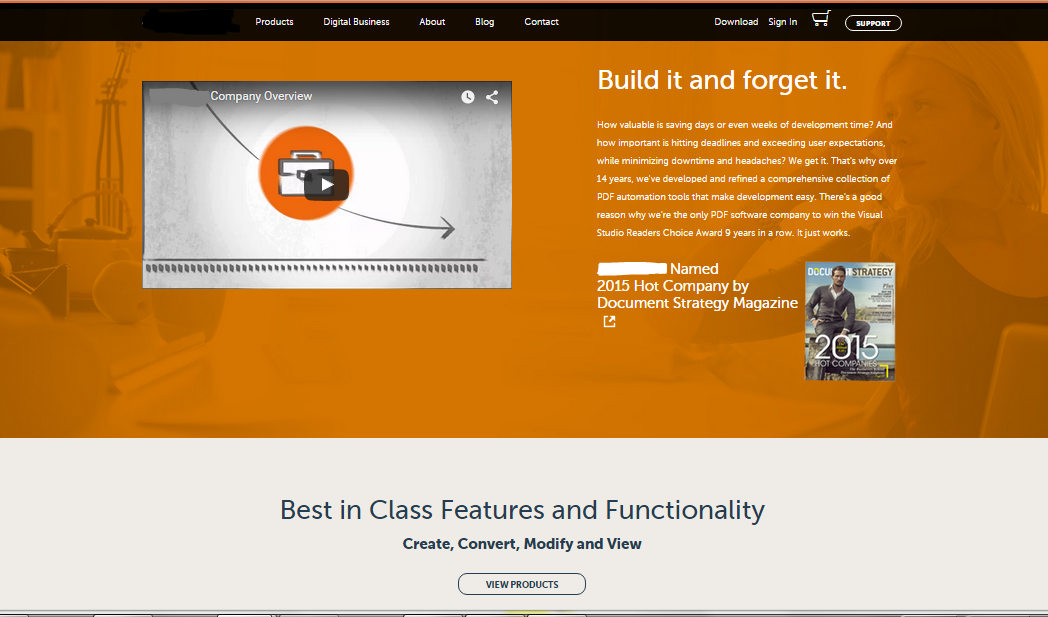Because content marketing is a relatively new approach, some businesses are just winging it. They know they need content to be competitive – so they invest on an experimental basis, throwing what they create against a wall to see what sticks. The problem is: They don’t know exactly what they need to reach their goals.
This is a waste. It’s a drain of your time, your resources and your marketing budget. You need content on your website, but there’s also a lot of content you DON’T need on your website.
We work with B2B software companies to produce content that helps them reach their most important marketing goals – lead generation and thought leadership. Here’s a no-nonsense guide to creating the kinds of content that will help you get better results from your web marketing:
1. Video
Specifically: Corporate promos, product demos, animated explainers
Video is the MOST important piece of content for a B2B software company. It’s an intuitive way to educate your prospects on exactly what your product does, how it works and why it solves their biggest problems.
Forgive the cliche, but they say a picture is worth a thousand words. This couldn’t be more true than when it comes to learning a new program or piece of technology. A study from Animoto found that:
-
4 out of 5 consumers think product demo videos are helpful
-
25% of consumers lose interest if a company doesn’t have a video
-
4x as many people would rather watch a video about a product than read about it
Animated explainers are particularly effective for B2B software companies at the beginning of the purchase journey. This kind of video gives could-be customers an inside look at your software, so they have a better sense of how they would use it on the job. Be careful not to go too in-depth with these videos. Keep them at 60-90 seconds maximum or you’ll lose your audience’s attention.
Besides being excellent educational tools, videos also make good tools for lead generation. One of our clients wanted an always-on sales tool. We produced a product overview video for the company to publish on a landing page, and it now acts as a 24/7/365 sales tool available when people visit the website.

Here’s how a company generated over 100 conversions with a video that explained its business process management platform: Appian, Drives Conversions With Video Marketing.
2. Optimized landing pages
Specifically: Product pages, a „who we serve“ page, resource pages, support pages and about us
Your homepage isn’t the most valuable part of your website – your landing pages are.
We recently conducted a deep dive into our B2B software clients’ content and found that product landing pages are responsible for 33 percent of the backlinks they get.
When people recommend your products, they’re not going to send people to your home page. They’re sending people straight to your product pages. And the content they find there has to good enough to convince them that your business is worth a closer look – that they need your technology to become more efficient and successful.
How strong are your landing pages? If someone who is unfamiliar with your company looked at your product landing pages, would they find it easy to understand what you do with a quick glimpse of the page? Or would they have to dig through technical specs to figure it out?
A good landing page should have:
-
Content that clearly explains your product features and how they benefit customers
-
Relevant keywords that support your search strategy
-
Pictures and/or videos to show the product
-
Outside research to build trust
-
Customer quotes to back up your claims
-
CTAs that tell viewers what to do next
For more secrets on building the perfect landing pages, download our free eBook on the Landing Page Triangle.
The best content marketing strategies for B2B software companies start with landing page optimization. A strong foundation sets your site up for conversion success and supports the relevant keywords you want to rank for in search.
Over 91% of companies are optimizing their landing pages to increase conversion rates, and 79% say they’re effective.
3. Calls To Action (CTAs)
Specifically: CTAs for gated assets like white papers, eBooks,and CTAs for your blog pages
To generate leads, you need to make conversions effortless. A website must have clear and easy-to-use CTA buttons or form fills. These act as gates to help you get visitors to take an action that’s meaningful to your sales cycle, such as:
-
Taking a demo of your software
-
Contacting your sales team for more information about your solutions
-
Purchasing your software
-
Downloading white papers, eBooks or infographics about your technology
A good CTA stands out on the page. It’s attractive and makes use of visual content. The call to action should grab readers‘ attention and use clear, actionable language to push them toward taking a ’next step.‘
Small language tweaks and simple design changes can have a huge effect on the success of your call to action. Here’s just one example of how we made basic changes and increased a company’s conversion rate 40x.
If you have good CTAs on your website, your blog readers will know exactly what to do next when they want to learn more. They can click buttons right on the page to download an eBook about how to become more efficient, sign up for a product demo or contact a member of your sales team.
This is how you create the most opportunities to generate leads from the people who are already visiting your site and reading your content.
4. Testimonials and Case Studies
B2B software is a competitive space. You need proof that your products have worked for customers in the past to get new prospects to buy in. Before a decision maker is ever involved, prospects want to feel confident you can help them. They need to know you have a positive track record with company like theirs.
Customer testimonials, case studies and success stories offer the evidence that builds trust with cautious consumers. These assets combine cold-hard results with real customer narratives. Pulling back the curtain, you give potential customers access to your existing clientele to find out what it’s like to work with you.
Over 40% of technology buyers have read case studies in the past 6 months to evaluate their options
This level of transparency, across a wide swathe of customers in different verticals, builds trust that can put your company on the shortlist of software vendors. Over 40 percent of technology buyers say they’ve read case studies in the past six months to evaluate their options. One-third say it’s the most influential piece of content in their purchase decision.
If you’re just getting started with a content strategy, you might find it’s easier to build an archive of testimonial videos than case studies. Assuming you have a number of customers willing to participate, testimonials can be quick to produce and they let your prospects meet your customers face to face (almost).
5. Downloadable resources
Specifically: eBook, white papers, infographics – even videos
Last, but not least, B2B software companies should have a resource center on their websites where visitors can download white papers, eBooks, fact sheets and even infographics*.
*We publish infographics on our site on a landing page without any gate. However, some of our clients have seen great results when they publish them behind a formfill as a lead gen tool. Here’s a case study that explains how a mobile app company broke its lead gen record with this strategy.
Resources that promote thought leadership, such as white papers, can make or break sales opportunities. People are looking for information online, and they expect to find answers to their more important questions for free (and without having to talk to your sales team).
To be competitive, you need to provide prospects with tangible value before they’re even bonafide leads. While you can’t ask them to pay for this initial consultation, you can ask them to hand over some contact details in exchange for the resources they want.
Pro-tip: Don’t get greedy with the ask. People are far less likely to complete a form fill that asks for too many details. Keep it short and ask for as little as possible.
A well-stocked content arsenal provides instant & long-term marketing wins
These five content types are the ammunition every B2B software company needs for its online marketing to be successful. While they may not be the sexiest formats out there, they will set you up for marketing wins – immediate and long-term.
It’s essential that you tell people who you are, what you do, why they should partner with you and how to proceed with the relationship. Once this foundation set, you are in the best position to expand on your initial wins with supporting content formats, such as blogs and infographics, webinars and social media ads that further your reach, build your brand and help you become a thought leader.
Want more examples of how B2B software companies see success with content marketing strategies? Check out these related resources:





